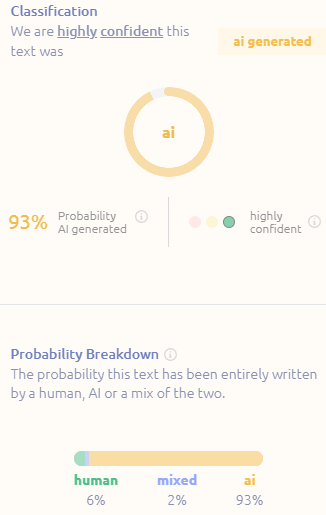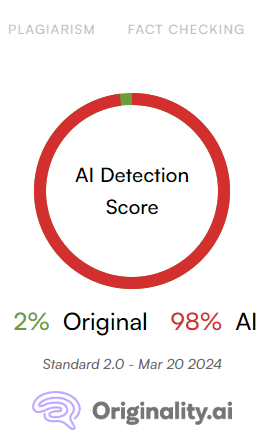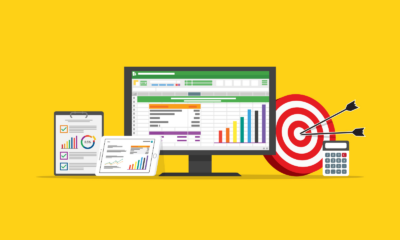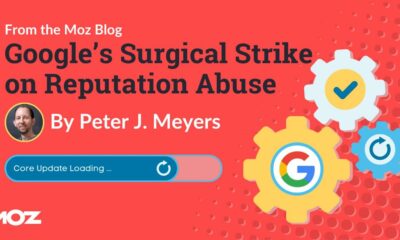SEO
AI Spam Sites Beat Google’s March 2024 Spam Update

While honest websites experienced the ups and downs of Google’s March 2024 update, SEOs and recipe bloggers noticed AI spam sites surging to the top of search results. One example as of yesterday ranked for over 217K queries, 14.9K of which rank in the top 10 – and that number has increased a day later. This is what’s going on and how the spammers continue to beat Google.
Surge In March 2024
The site that’s ranking is a subdomain. The main domain has been around since the summer of 2020. The spammy subdomain was first spotted by the Internet Archive on November 30 2022, coincidentally the launch date of ChatGPT. The subdomain was in a half-finished and essentially dormant until March 2024 when it rapidly expanded and immediately began to rank for thousands of search queries.
Wednesday March 20th the site was ranking 14.9k search queries in the top 10. Thursday March 21st the site had 15.6K in the top 10. Even though Google just concluded their spam update, this particular site (and others like it) continue to rank for thousands of search queries and Google appears powerless to stop them.
Food Writer Reacts To AI Spam
A food writer and cookbook author, Robin Donovan (Instagram), called my attention to the AI site, telling me that others in a private Facebook group were livid about AI sites surging for recipe search queries.
It’s super obvious that the content is AI generated, even the images accompanying the articles are 100% AI. So it’s especially hurtful to those with experience, expertise and authoritativeness to see obviously AI content outrank them.
Robin was understandably upset:
“How on earth is this the best content? And meanwhile, bloggers who are professionally trained chefs, recipe developers, cookbook authors, and others with decades of training and experience are watching their sites be decimated with these updates. Sites that they’ve spent years building with well-researched, well-written (human-written!) articles, recipes that have been professionally developed and carefully tested, photographs they have spent hours prepping for and shooting.
They’ve done all the things Google has told them to do for years—write your own content, take your own photos, develop unique, high-quality recipes, be an expert in your subject area and have credentials to show it, don’t try to game the system, be genuine, create HELPFUL content. For what?”
Details About The Spam Sites Look Like
1. Hosted On Squarespace
The spam site is on a subdomain and both the subdomain and the main site are hosted on Squarespace. Why Squarespace? Just a guess but maybe that infrastructure tends to generally appear legit to Google (or it might not play a role).
2. All Images Are Colorful And Simple
All of the images are AI generated, created in a flat colorful style similar to what might be seen in an infographic, indicating that a templated prompt was used to create the thousands of images accompanying the articles.
The images are an important component of the articles. Each article features about seven images that relate to the overall topic of the article. Every article contains a rainbow’s worth of colors. I don’t know if the images are intentionally bright and colorful but the use of strong colors is a good strategic choice for images because they pop out in the SERPs, Google Discover and in Google SGE.
I uploaded one of the images to ChatGPT and asked it to generate a prompt based on the image to create a new one in the same style.
Here’s an example of an AI generated image in the same style as the AI spam sites:
Example Of An AI Generated Image Used By A Spam Site

Related: Beyond SEO: John Mueller On AI-Generated Images
3. All Articles Follow A Rigid Template
The articles follow a templated structure, which varies depending on the type of article. Article topics range from comparisons, local destination travel, lifestyle, recipes, health benefits of certain foods and so on.
The health related articles follow this template structure:
a. Introduction
Introduces the concept topic being discussed and its relevance to a specific health related topic. The concept topic can be a particular food, a type of diet and so on.
b. Health Benefits
Following the introduction, every discusses the health benefits associated with the concept topic.
c. Fundamentals
This section discusses the basics of the health topic that is being focused on (oral health, diabetes…), the importance of nutrition, and common problems or diseases associated with the health topic.
d. Nutritional Guidance And Key Nutrients
e. Dietary Choices And Impact On Health
f. Tips and Lifestyle Advice
g. A summary of the benefits
4. Underlying Prompt For AI-Generated Articles
I was curious about what a prompt that generates that content would look like so I asked ChatGPT to create one.
This is a generalized prompt that could have been used to create the health and diet articles:
“Write an article exploring the connection between [concept of dietary choice] and [specific health focus], following the template below:
a. Introduction: Begin by introducing the concept of [concept of dietary choice], its definition, and why it’s relevant to [specific health focus].
Discuss its growing popularity and how it aligns with contemporary health and lifestyle trends.
b. Health Benefits:
Elaborate on the general health benefits associated with [concept of dietary choice], focusing on its potential to enhance [specific health focus].
c. Fundamentals of [Health Topic]:
Provide a background on the [specific health focus], including essential anatomy, the significance of nutrition, and prevalent conditions affecting this aspect of health.
d. Key Nutrients and Their Impact:
Detail the crucial nutrients that play a significant role in [specific health focus], including their sources and the health benefits they offer. Highlight the importance of certain vitamins, minerals, and other compounds.
e. Influence of Dietary Choices:
Analyze how specific dietary choices influenced by [concept of dietary choice] can impact [specific health focus], positively or negatively. Recommend beneficial foods and advise against certain types that may harm [specific health focus].
f. Practical Advice for Diet and Lifestyle:
Offer practical suggestions for integrating beneficial foods into one’s diet and making lifestyle adjustments to support [specific health focus]. This might include tips on meal preparation, portion control, and balancing different types of foods.
g. A Prompt To Use To Generate A Conclusion:
Conclude the article by summarizing how adopting [concept of dietary choice] can contribute to improving [specific health focus].
Emphasize the balance and variety of nutrients this approach provides and its potential benefits beyond [specific health focus]. Ensure the article provides a comprehensive overview that is both informative and engaging, catering to readers interested in understanding the relationship between [concept of dietary choice] and [specific health focus].”
5. Content Tested By AI Checker Tools
The weird thing about these articles is that every article I tested with GPTZero AI Content Detector scored 100% as AI-generated. The Originality.AI content checker offered similar scores.
Screenshot Of GPTZero Score


Screenshot Of Originality.AI Score


The Squarespace templates are professional and the articles themselves are in a dry style that is informative but lacks signals of human authorship such as expressions of insight or experience and a complete absence of colloquialisms. Every article tested failed the AI detection tests.
Related: AI Generated Content Detection Software: Can They Detect ChatGPT?
6. How Do AI Spam Sites Rank?
It’s my hypothesis that the reason these spam sites rank is that they’re taking advantage of a loophole in Google’s algorithms that allows new content to receive an initial boost, what Google’s John Mueller has described as Google testing the website or the webpages out. This happens all the time and excites people when they publish a new site and see it ranking almost right away.
What is happening with this one AI generated website is that it is publishing massive amounts of webpages every day and those pages receive a boost to the top of the search engine results pages (SERPs) for the first 24 to 48 hours. They then begin to slip down the top ten and eventually into the second pages of the SERPs.But by that time there are new pages begining that journey from the initial boost, every day. This is a classic old school strategy known as churn and burn.
John Mueller has commented in the past about why Google ranks new websites at the top of search results.
He explained:
“In particular, with completely new websites, one of the difficulties that we have is we might not have a lot of signals for those websites so we have to make estimates.
And depending on how we make estimates, it can sometimes mean that in the beginning we show this website a little bit more visibly than like it turns out that the signals tell us in the end.
…But that can go both ways. It can go in the direction of like you’re shown very visibly in the beginning.
And it can also be that maybe you’re shown less visibly in the beginning and as we understand your website and how it fits in with the rest of the web then we can kind of adjust that.
…Sometimes it’s also new websites that show up that we try to pick up really quickly.”
7. AI Spam Is A Longstanding Problem With Google
Google has a longstanding problem with AI generated sites dominating certain search results and this is not the first time that Google has been overwhelmed by spam. This one spam site is not the only one and it is not an outlier.
I suspect that fixing the loopholes that allow this spam to happen probably has unintended consequences that adversely affects non-spam sites and that’s why Google hasn’t closed it after all these years.
But Google needs to do something about it because it affects expert authors when their sites are outranked by non-human content that lacks insights and expertise. If not for the publishers sake then for their own sake because the general public already has the perception that Google can’t fix their spam problem.
What makes this example noteworthy is that it went live simultaneously with Google’s spam update and it sailed right through it unaffected, thumbing it’s nose at Google. It’s a humiliating and demoralizing experience for the thousands of bloggers who do the right thing only to see the cheaters rewarded yet again.
See also: Google’s Algorithm Hates AI Content? How To Make Google Love It
Featured Image by Shutterstock/ViDI Studio
SEO
Google Rolls Out New ‘Web’ Filter For Search Results

Google is introducing a filter that allows you to view only text-based webpages in search results.
The “Web” filter, rolling out globally over the next two days, addresses demand from searchers who prefer a stripped-down, simplified view of search results.
Danny Sullivan, Google’s Search Liaison, states in an announcement:
“We’ve added this after hearing from some that there are times when they’d prefer to just see links to web pages in their search results, such as if they’re looking for longer-form text documents, using a device with limited internet access, or those who just prefer text-based results shown separately from search features.”
We’ve added this after hearing from some that there are times when they’d prefer to just see links to web pages in their search results, such as if they’re looking for longer-form text documents, using a device with limited internet access, or those who just prefer text-based…
— Google SearchLiaison (@searchliaison) May 14, 2024
The new functionality is a throwback to when search results were more straightforward. Now, they often combine rich media like images, videos, and shopping ads alongside the traditional list of web links.
How It Works
On mobile devices, the “Web” filter will be displayed alongside other filter options like “Images” and “News.”
If Google’s systems don’t automatically surface it based on the search query, desktop users may need to select “More” to access it.
 Screenshot from: twitter.com/GoogleSearchLiaison, May 2024.
Screenshot from: twitter.com/GoogleSearchLiaison, May 2024.More About Google Search Filters
Google’s search filters allow you to narrow results by type. The options displayed are dynamically generated based on your search query and what Google’s systems determine could be most relevant.
The “All Filters” option provides access to filters that are not shown automatically.
Alongside filters, Google also displays “Topics” – suggested related terms that can further refine or expand a user’s original query into new areas of exploration.
For more about Google’s search filters, see its official help page.
Featured Image: egaranugrah/Shutterstock
SEO
Why Google Can’t Tell You About Every Ranking Drop

In a recent Twitter exchange, Google’s Search Liaison, Danny Sullivan, provided insight into how the search engine handles algorithmic spam actions and ranking drops.
The discussion was sparked by a website owner’s complaint about a significant traffic loss and the inability to request a manual review.
Sullivan clarified that a site could be affected by an algorithmic spam action or simply not ranking well due to other factors.
He emphasized that many sites experiencing ranking drops mistakenly attribute it to an algorithmic spam action when that may not be the case.
“I’ve looked at many sites where people have complained about losing rankings and decide they have a algorithmic spam action against them, but they don’t. “
Sullivan’s full statement will help you understand Google’s transparency challenges.
Additionally, he explains why the desire for manual review to override automated rankings may be misguided.
Two different things. A site could have an algorithmic spam action. A site could be not ranking well because other systems that *are not about spam* just don’t see it as helpful.
I’ve looked at many sites where people have complained about losing rankings and decide they have a…
— Google SearchLiaison (@searchliaison) May 13, 2024
Challenges In Transparency & Manual Intervention
Sullivan acknowledged the idea of providing more transparency in Search Console, potentially notifying site owners of algorithmic actions similar to manual actions.
However, he highlighted two key challenges:
- Revealing algorithmic spam indicators could allow bad actors to game the system.
- Algorithmic actions are not site-specific and cannot be manually lifted.
Sullivan expressed sympathy for the frustration of not knowing the cause of a traffic drop and the inability to communicate with someone about it.
However, he cautioned against the desire for a manual intervention to override the automated systems’ rankings.
Sullivan states:
“…you don’t really want to think “Oh, I just wish I had a manual action, that would be so much easier.” You really don’t want your individual site coming the attention of our spam analysts. First, it’s not like manual actions are somehow instantly processed. Second, it’s just something we know about a site going forward, especially if it says it has change but hasn’t really.”
Determining Content Helpfulness & Reliability
Moving beyond spam, Sullivan discussed various systems that assess the helpfulness, usefulness, and reliability of individual content and sites.
He acknowledged that these systems are imperfect and some high-quality sites may not be recognized as well as they should be.
“Some of them ranking really well. But they’ve moved down a bit in small positions enough that the traffic drop is notable. They assume they have fundamental issues but don’t, really — which is why we added a whole section about this to our debugging traffic drops page.”
Sullivan revealed ongoing discussions about providing more indicators in Search Console to help creators understand their content’s performance.
“Another thing I’ve been discussing, and I’m not alone in this, is could we do more in Search Console to show some of these indicators. This is all challenging similar to all the stuff I said about spam, about how not wanting to let the systems get gamed, and also how there’s then no button we would push that’s like “actually more useful than our automated systems think — rank it better!” But maybe there’s a way we can find to share more, in a way that helps everyone and coupled with better guidance, would help creators.”
Advocacy For Small Publishers & Positive Progress
In response to a suggestion from Brandon Saltalamacchia, founder of RetroDodo, about manually reviewing “good” sites and providing guidance, Sullivan shared his thoughts on potential solutions.
He mentioned exploring ideas such as self-declaration through structured data for small publishers and learning from that information to make positive changes.
“I have some thoughts I’ve been exploring and proposing on what we might do with small publishers and self-declaring with structured data and how we might learn from that and use that in various ways. Which is getting way ahead of myself and the usual no promises but yes, I think and hope for ways to move ahead more positively.”
Sullivan said he can’t make promises or implement changes overnight, but he expressed hope for finding ways to move forward positively.
Featured Image: Tero Vesalainen/Shutterstock
SEO
56 Google Search Statistics to Bookmark for 2024

If you’re curious about the state of Google search in 2024, look no further.
Each year we pick, vet, and categorize a list of up-to-date statistics to give you insights from trusted sources on Google search trends.
- Google has a web index of “about 400 billion documents”. (The Capitol Forum)
- Google’s search index is over 100 million gigabytes in size. (Google)
- There are an estimated 3.5 billion searches on Google each day. (Internet Live Stats)
- 61.5% of desktop searches and 34.4% of mobile searches result in no clicks. (SparkToro)
- 15% of all Google searches have never been searched before. (Google)
- 94.74% of keywords get 10 monthly searches or fewer. (Ahrefs)
- The most searched keyword in the US and globally is “YouTube,” and youtube.com gets the most traffic from Google. (Ahrefs)
- 96.55% of all pages get zero search traffic from Google. (Ahrefs)
- 50-65% of all number-one spots are dominated by featured snippets. (Authority Hacker)
- Reddit is the most popular domain for product review queries. (Detailed)
- Google is the most used search engine in the world, with a mobile market share of 95.32% and a desktop market share of 81.95%. (Statista)


- Google.com generated 84.2 billion visits a month in 2023. (Statista)
- Google generated $307.4 billion in revenue in 2023. (Alphabet Investor Relations)
- 63.41% of all US web traffic referrals come from Google. (SparkToro)
- 92.96% of global traffic comes from Google Search, Google Images, and Google Maps. (SparkToro)
- Only 49% of Gen Z women use Google as their search engine. The rest use TikTok. (Search Engine Land)
- 58.67% of all website traffic worldwide comes from mobile phones. (Statista)
- 57% of local search queries are submitted using a mobile device or tablet. (ReviewTrackers)


- 51% of smartphone users have discovered a new company or product when conducting a search on their smartphones. (Think With Google)
- 54% of smartphone users search for business hours, and 53% search for directions to local stores. (Think With Google)
- 18% of local searches on smartphones lead to a purchase within a day vs. 7% of non-local searches. (Think With Google)
- 56% of in-store shoppers used their smartphones to shop or research items while they were in-store. (Think With Google)
- 60% of smartphone users have contacted a business directly using the search results (e.g., “click to call” option). (Think With Google)
- 63.6% of consumers say they are likely to check reviews on Google before visiting a business location. (ReviewTrackers)
- 88% of consumers would use a business that replies to all of its reviews. (BrightLocal)
- Customers are 2.7 times more likely to consider a business reputable if they find a complete Business Profile on Google Search and Maps. (Google)
- Customers are 70% more likely to visit and 50% more likely to consider purchasing from businesses with a complete Business Profile. (Google)
- 76% of people who search on their smartphones for something nearby visit a business within a day. (Think With Google)
- 28% of searches for something nearby result in a purchase. (Think With Google)
- Mobile searches for “store open near me” (such as, “grocery store open near me” have grown by over 250% in the last two years. (Think With Google)
- People use Google Lens for 12 billion visual searches a month. (Google)
- 50% of online shoppers say images helped them decide what to buy. (Think With Google)
- There are an estimated 136 billion indexed images on Google Image Search. (Photutorial)
- 15.8% of Google SERPs show images. (Moz)
- People click on 3D images almost 50% more than static ones. (Google)
- More than 800 million people use Google Discover monthly to stay updated on their interests. (Google)
- 46% of Google Discover URLs are news sites, 44% e-commerce, 7% entertainment, and 2% travel. (Search Engine Journal)
- Even though news sites accounted for under 50% of Google Discover URLs, they received 99% of Discover clicks. (Search Engine Journal)


- Most Google Discover URLs only receive traffic for three to four days, with most of that traffic occurring one to two days after publishing. (Search Engine Journal)
- The clickthrough rate (CTR) for Google Discover is 11%. (Search Engine Journal)
- 91.45% of search volumes in Google Ads Keyword Planner are overestimates. (Ahrefs)
- For every $1 a business spends on Google Ads, they receive $8 in profit through Google Search and Ads. (Google)
- Google removed 5.5 billion ads, suspended 12.7 million advertiser accounts, restricted over 6.9 billion ads, and restricted ads from showing up on 2.1 billion publisher pages in 2023. (Google)
- The average shopping click-through rate (CTR) across all industries is 0.86% for Google Ads. (Wordstream)
- The average shopping cost per click (CPC) across all industries is $0.66 for Google Ads. (Wordstream)
- The average shopping conversion rate (CVR) across all industries is 1.91% for Google Ads. (Wordstream)
- 58% of consumers ages 25-34 use voice search daily. (UpCity)
- 16% of people use voice search for local “near me” searches. (UpCity)
- 67% of consumers say they’re very likely to use voice search when seeking information. (UpCity)
- Active users of the Google Assistant grew 4X over the past year, as of 2019. (Think With Google)
- Google Assistant hit 1 billion app installs. (Android Police)
- AI-generated answers from SGE were available for 91% of entertainment queries but only 17% of healthcare queries. (Statista)
- The AI-generated answers in Google’s Search Generative Experience (SGE) do not match any links from the top 10 Google organic search results 93.8% of the time. (Search Engine Journal)
- Google displays a Search Generative element for 86.8% of all search queries. (Authoritas)


- 62% of generative links came from sources outside the top 10 ranking organic domains. Only 20.1% of generative URLs directly match an organic URL ranking on page one. (Authoritas)
- 70% of SEOs said that they were worried about the impact of SGE on organic search (Aira)
Learn more
Check out more resources on how Google works:
-

 PPC6 days ago
PPC6 days agoHow the TikTok Algorithm Works in 2024 (+9 Ways to Go Viral)
-

 SEO5 days ago
SEO5 days agoHow to Use Keywords for SEO: The Complete Beginner’s Guide
-

 MARKETING6 days ago
MARKETING6 days agoHow To Protect Your People and Brand
-

 MARKETING4 days ago
MARKETING4 days agoAdvertising on Hulu: Ad Formats, Examples & Tips
-

 MARKETING4 days ago
MARKETING4 days agoUpdates to data build service for better developer experiences
-

 MARKETING5 days ago
MARKETING5 days agoThe Ultimate Guide to Email Marketing
-

 SEO7 days ago
SEO7 days agoAutomate Multi-Site Reporting With Google Sheets And GSC API
-

 MARKETING22 hours ago
MARKETING22 hours ago18 Events and Conferences for Black Entrepreneurs in 2024













